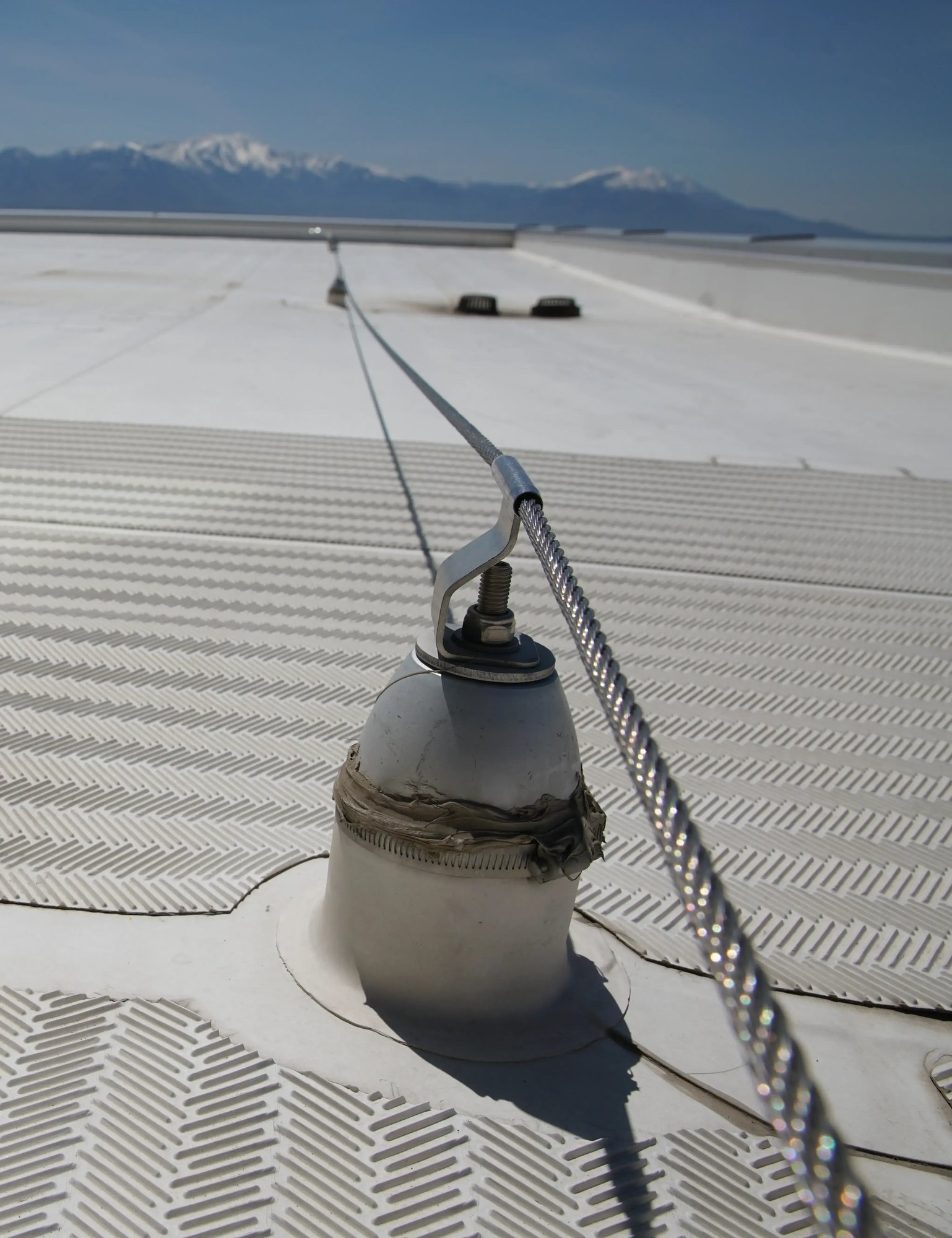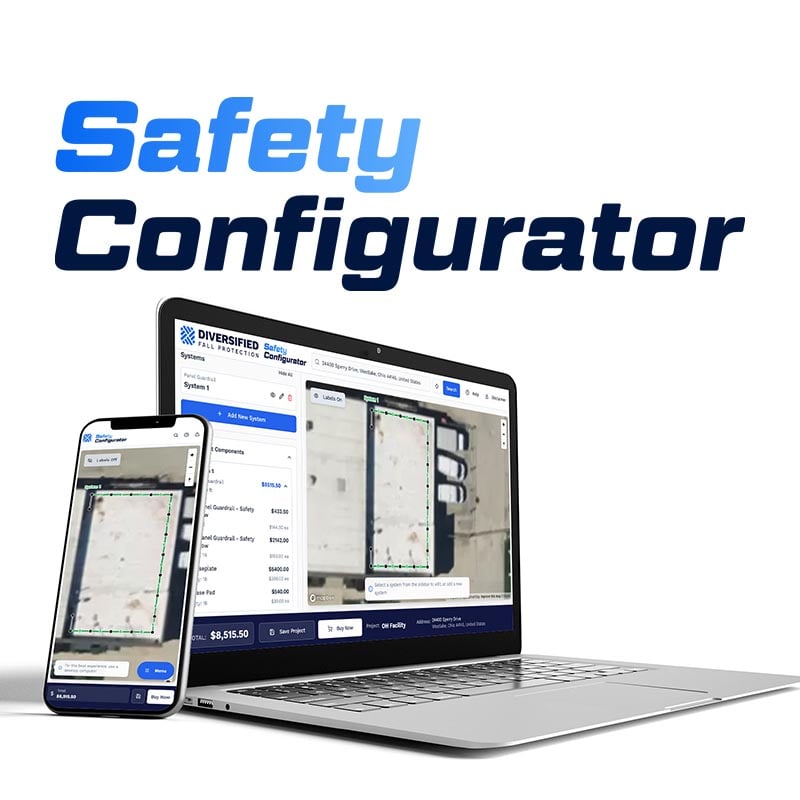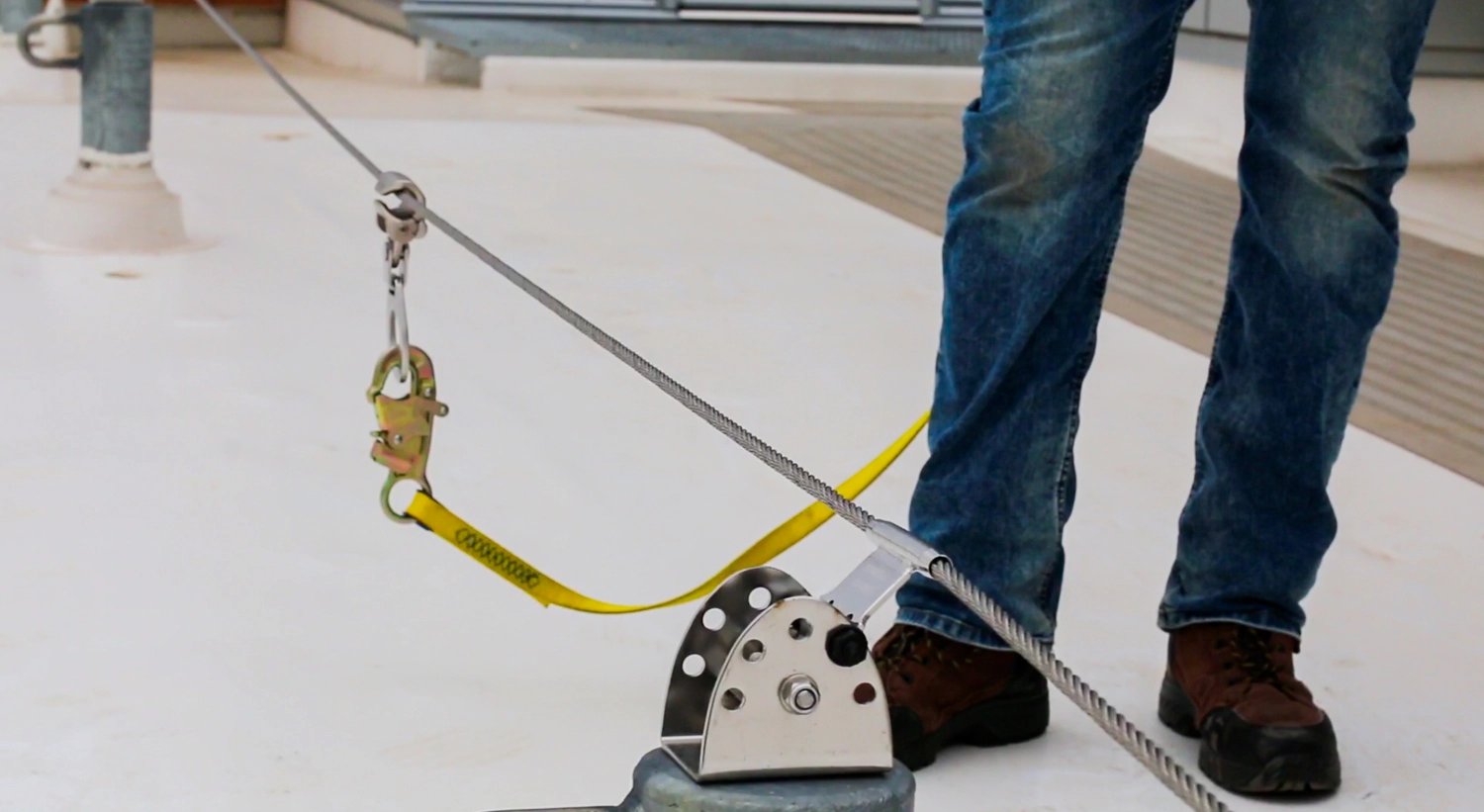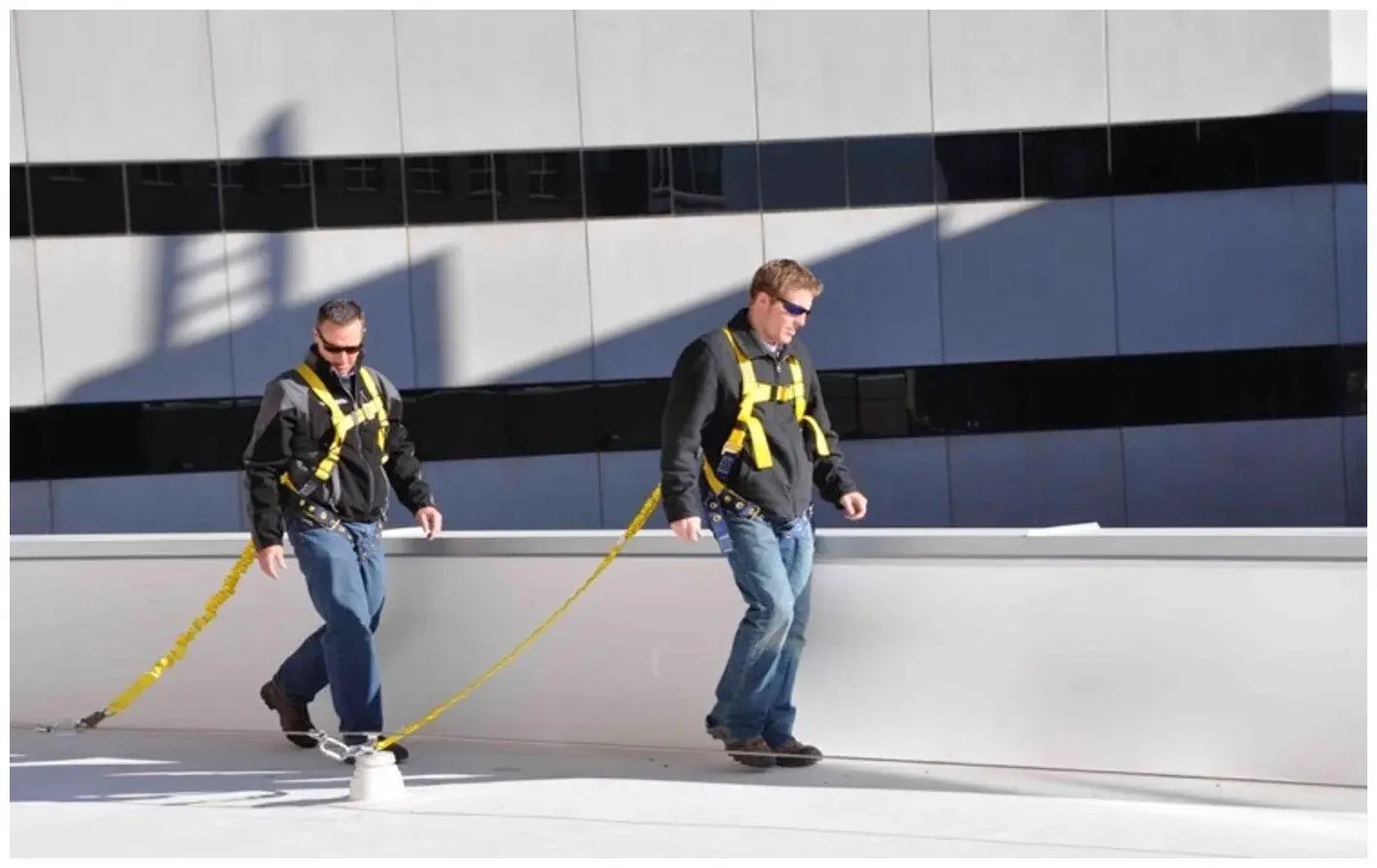Horizontal Lifeline Systems
Custom and Pre-Engineered Lifeline Systems to Meet Your Application’s Needs
The horizontal lifeline consists of a cable attached to two or more anchor points on a rooftop, crane runway, bridge, or outdoor construction site, or any other elevated work area that poses a fall risk to personnel. A horizontal lifeline can be positioned at the base of the structure (e.g., a roof), overhead (e.g., a gallows style system commonly used for railcar and truck load/unloading applications), or somewhere in between these points (e.g., a crane rail application).
When used in combination with personal protective equipment, a horizontal lifeline can arrest a fall, limiting the amount of force that is transferred both to the worker and the fall arrest system. This same combination of horizontal lifeline, body harness, and lanyard can also serve as a fall restraint system, limiting the worker’s ability to move close enough to fall over an unprotected leading edge. The fall restraint and fall arrest properties of horizontal lifelines make the HLL an integral part of many fall protection systems.

System Types
Diversified Fall Protection a complete turnkey provider of OSHA compliant horizontal lifeline systems. Contact us for expert assistance with your fall arrest, fall restraint and fall protection requirements.
Design Considerations
Horizontal lifelines can offer the following advantages:
- Provides fall protection coverage across a wide distance. The distance spanned by a horizontal lifeline is limited only by the ability to attach a series of anchor points to surrounding structure. For example, crane rail HLL systems can safely span distances in excess of 600 feet.
- Impart smaller footprints on elevated work spaces
- Lighter than fabricated steel solutions
- Constructed from stainless steel components, horizontal lifelines offer corrosion resistance and exceptional component longevity.
- Does not require the time to custom fabricate relative to steep fall protection systems
- Does not require the time to custom fabricate relative to steep fall protection systems
Special care must be taken to account for the loads on various anchor points and deflection in the event of a fall, thus requiring certified and experienced engineering and installation capabilities. Each anchor point must be secure enough to withstand the forces associated a fall and a thorough review of the work area is needed to ensure that a worker will not strike pipes, equipment, or other surfaces when falling. Load and deflection rates are determined by a number of factors, including pre-tension of the cable, length of the area spanned by the horizontal lifeline, and the number of workers connected to the system.
Horizontal Lifeline Systems FAQ
Horizontal lifeline systems offer several important benefits for worker safety and productivity:
-
Continuous fall protection over a wide area: An HLL provides continuous tie-off, meaning workers don’t need to disconnect and reconnect as they move, unlike with single anchors. This constant protection significantly reduces the chance of a fall during transitions.
-
Greater freedom of movement: Workers attached to a horizontal lifeline can move hands-free along the line and cover a larger work area, maintaining mobility and efficiency while staying safe. This is especially useful for long rooftops, loading bays, bridge girders, or anywhere a worker must travel some distance at height.
-
Multiple workers on one system: Many horizontal lifeline systems are rated to protect two users at the same time, and specialized multi-span systems can accommodate even more, allowing a team to work together safely on the same line. This promotes teamwork and consistent protection for all personnel in the area.
-
Enhanced safety compliance: Using an HLL helps ensure your operation meets or exceeds OSHA and ANSI fall protection requirements while keeping the focus on actual worker safety. In addition to regulatory compliance, the presence of a robust lifeline system builds a strong safety culture by actively preventing falls.
Overall, horizontal lifelines improve employee safety at heights by providing reliable fall arrest capability without unduly limiting the workers’ range of motion. They strike a balance between safety and practicality, enabling workers to perform their jobs efficiently while remaining protected from deadly falls.
Always refer to the manufacturer’s instructions and engineering guidelines for the exact capacity of your horizontal lifeline system, and never exceed the recommended number of users.
Most horizontal lifeline systems are designed to support two users at a time on a single span of lifeline. For example, one major manufacturer specifies that their temporary lifeline can be up to 60 ft long and safely accommodate a maximum of two workers simultaneously (one or two users on the line). Typically, each user is also subject to a weight limit (often around 310 lbs per person including tools and gear) to ensure the system can arrest a fall safely.
Allowing more than two people on one lifeline greatly increases the forces on the system, so additional users are generally not recommended unless the system has been specifically engineered for it. Some advanced permanent lifeline setups with multiple spans or specialized energy absorbers can handle more users – for instance, there are multi-span cable systems that allow “two users per span, up to six users per system” when properly configured. However, any increase in capacity must be verified by a qualified engineer and comply with the system’s design specifications. In practice, two workers per lifeline is the common safe limit unless documentation says otherwise.
Regular inspection and maintenance of a horizontal lifeline system is crucial for effective employee safety. Federal OSHA 1910 & 1926 require fall protection systems like HLLs be formally inspected at least once per year by a qualified individual or the organization's Competent Person. Many companies schedule comprehensive annual inspections by a trained safety professional or engineer to ensure the lifeline’s integrity. In addition, the system should be visually inspected before each use to catch any obvious issues (such as a damaged cable or a loose anchor) before workers connect to the system.
If a horizontal lifeline ever arrests a fall or shows signs of damage/wear, it must be removed from service immediately and not used again until it’s repaired or re-certified as safe. For example, if you notice a tension indicator has deployed (showing a shock absorber activated) or any part of the lifeline is bent, frayed, or corroded, stop using it right away. Below are some key things to look for during HLL inspections:
- Anchors and hardware: Check all end anchors, intermediate brackets, bolts, and fittings for any deformation, cracks, looseness or corrosion. The anchor points should be solid and show no signs of failing or pulling out.
- Lifeline cable or rope: Inspect the full length of the cable or rope for fraying, cuts, kinks, broken wires, excessive slack or stretching, or any kind of deterioration. Any damaged section of line is a serious hazard.
- Connectors and components: Examine turnbuckles, shackles, carabiners, and trolleys/shuttles for wear, rust, or malfunction. Ensure any moving parts (like the shuttle that glides along the line) are intact and function smoothly.
- Energy absorbers/indicators: If the system has an inline energy absorber or a visual impact indicator, verify that it has not been deployed or tripped (many systems have a tear-web or color indicator that shows if a fall force occurred). A triggered absorber or indicator is a sign the system experienced a fall and needs replacement or factory recertification.
- Path and mounting: Confirm there are no new obstructions, sharp edges, or abrasive surfaces along the lifeline’s path that could damage it. Also, ensure any coatings or roof sealants around anchors remain intact to prevent leaks or structural damage.
By diligently inspecting these systems on a regular schedule, you can catch problems early and ensure the horizontal lifeline will perform as expected to protect workers. Remember that maintaining the lifeline in good condition is as important as installing it correctly – a neglected HLL can become unsafe over time.
Because horizontal lifeline systems directly affect life safety, they should be designed and installed by qualified professionals. In fact, OSHA regulations require that HLL systems be “designed, installed, and used, under the supervision of a qualified person”. A Qualified Person in this context is typically a professional engineer or a safety expert with specialized training and experience in fall protection system design. This person has the expertise to analyze loads, select appropriate components, and ensure the system has an adequate safety factor for fall arrest.
In practical terms, a trained Competent Person (such as a certified safety supervisor or installer) may handle the physical installation of a pre-engineered horizontal lifeline kit on site, but the system’s configuration and anchor points should still be approved or certified by a Qualified Person (engineer). This means that the distances between anchors, the sag/tension of the cable, the anchorage strength, and the number of users are all reviewed by someone with the proper engineering knowledge. Having a qualified engineer design or sign off on the system is critical, because they will ensure the lifeline will support the required loads with the necessary 2:1 safety factor and account for dynamics of a fall on a horizontal lifeline system.
Attempting to install a horizontal lifeline without the input of a qualified professional is extremely risky – miscalculating the forces or using the wrong components could result in the system failing during a fall. To keep your employees safe, always involve a qualified fall protection engineer or a reputable fall protection company when setting up a horizontal lifeline system. Their expertise will ensure the system is not only compliant on paper, but truly effective in the field.
Horizontal lifeline systems must be attached to very strong anchor points that can sustain the high forces generated during a fall. Typically, HLL end anchors are structural elements like steel beams, concrete columns, or engineered anchor posts that have been certified for fall protection loads. OSHA requires that a fall arrest anchor (which includes HLL anchor points) be capable of holding at least 5,000 pounds of force per person attached, or be designed with at least a two-to-one safety factor by an engineer. In plain terms, this means each end of the horizontal lifeline should be able to withstand around 22 kN (kilonewtons) of force without failure, in the direction that a fall would pull it. This is a very high load – for comparison, 5,000 lbs is roughly the force of a pickup truck hanging from the anchor – so only substantial structures or certified anchors are suitable.
When setting up an HLL, you may need to use anchorage connectors (devices that attach the lifeline to the structure) such as beam clamps, steel anchor loops, concrete anchor bolts, choker slings, or dedicated mounting stanchions. Whatever the type, each connector and anchorage must also be rated for 5,000 lbs or more to be safe for horizontal lifeline use. The anchors should be installed in a way that loads are transferred properly (e.g. perpendicular to a beam or flush in concrete as intended) and without deforming the structure. It’s highly recommended that a Competent Person or qualified engineer evaluate and certify the strength of each anchor location before the lifeline is used. They will confirm that the supporting structure can handle the forces (including the extra safety factor).
In summary, only pick anchor points that are structurally sound and rated for fall protection loads – never tie off a horizontal lifeline to something improvised or of uncertain strength (like pipes, guardrails, or lightweight roof members). Using the proper anchors is fundamental to the lifeline system’s integrity and to keeping workers safe in the event of a fall.
Yes. Horizontal lifeline systems are subject to important safety standards and regulations to ensure they protect workers effectively. In the United States, OSHA (Occupational Safety and Health Administration) sets minimum requirements for fall protection systems. OSHA’s construction and general industry standards (for example, 29 CFR 1926.502 and 1910.140) mandate that HLLs be designed, installed and used under the supervision of a qualified person and maintain a safety factor of at least two. OSHA also effectively requires that all lifeline components (lines, anchors, lanyards, etc.) have a minimum breaking strength of 5,000 lbs, unless a lesser strength is explicitly engineered with a sufficient safety factor. These regulations are essentially the legal baseline to prevent system failures.
In addition to OSHA rules (which are law), there are consensus standards and guidelines from organizations like ANSI (American National Standards Institute) and CSA (in Canada) that further detail how horizontal lifeline systems should perform. For instance, ANSI Z359 standards provide criteria for the design, dynamic performance, and testing of HLL systems, as well as requirements for inspecting and maintaining them. Following these best-practice standards helps ensure the system will arrest falls safely and can be used as part of a complete fall protection plan. In many cases, compliance with ANSI standards is considered evidence of due diligence in keeping workers safe, even if those standards themselves are voluntary.
Overall, any horizontal lifeline system you use should adhere to established safety standards – this means using equipment that has been designed and rated for fall protection and installing it in accordance with the manufacturer’s instructions and engineering guidelines. Meeting OSHA and ANSI criteria isn’t just about obeying rules; it translates directly into a higher level of confidence that the lifeline will perform as expected to save a worker’s life in the event of a fall. Always check that your HLL system components are certified and that the installation has been done by qualified personnel, so that you know the system is up to standard and ready to protect your employees.

b-1.jpg?width=1368&height=1340&name=Rail%20(175)b-1.jpg)





1.webp?width=500&height=380&name=HLL%20Overhead%20(661)1.webp)
.webp?width=640&height=429&name=pipe-rack-systems-1-1%20(1).webp)

